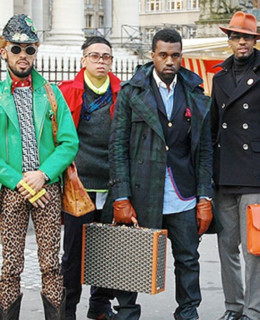“I wear your granddad’s clothes, I look incredible, I’m in this big ass coat, from that thrift shop down the road!” – Macklemore & Ryan Lewis, 2012
Thrifting has undergone quite the image change these last few years. Rebranded as “upcycling”, it’s being championed by a new generation of eco-conscious luxury brands and customers alike.
It has become impossible to ignore the disastrous impact of the fashion industry on the environment nowadays: there’s no turning away from its toxic pace and production process, nor to the massive dump of wasted textile (tonnes of it are either landfilled or burned every day) that is threatening our ecosystem. Seeking solutions to reduce said pile of garbage, many are now turning towards upcycling: taking back the waste and re-using it as new garments.
Consider it the chic little brother of recycling: whereas the latter is the first step towards a closed loop system that stops pressuring the scarce natural resources of our planet, upcycling takes it even further by putting forward products that are, from the very start, designed with the specific goal of nòt ending up as waste. It turns discarded textile into qualitative garments that can last at least a lifetime, and even after that prove long lasting enough to be reconstructed as a new design. Upcycling has been courting the fashion scene for decades, but until recently the romantic feelings were rather one-sided.
Ironically enough, for the longest time it wàs considered the only option: before the era of mass-consumption, people would endlessly patch up and fix their clothes, pass them on to one another or re-use them for other means. I once spoke to Levi’s in-house historian, who told me many of their original jeans have been discovered in the roofs of ruined farmhouses in the Midwest, the sturdy fabric turned into isolation material once it had outlived its time in the closet. Then came prêt-a-porter, the thrill of democratic prices and the joys of fast fashion. Which quickly turned into a nightmare, although no one seemed to notice it because it was (and still is) is dressed up in such a pretty night gown… Patch-ups and hand-me-downs became terribly out of fashion, no pun intended, and that was that.
Not everyone lived by that credo though, and in 1989 a young and relatively unknown Belgian designer named Martin Margiela shocked the fashion scene with a collection of hand-made garments, constructed out of old objects and fabrics. His rebellion against the luxury industry, inspired by Japanese designers such as Rei Kawakubo, translated into turning seemingly mundane things into something luxurious. He took it even further in 2006 with his biennial Artisanal collection, collected from both rare antique pieces and total crap, that was assembled with incredible craftsmanship in his Parisian atelier. The line was officially recognized as “haute couture” by the demanding Fédération Française de la Couture in 2012, and although he certainly did not invent the very concept of upcycling, Margiela would go on to inspire an entire generation of designers. Young creatives who needed some time to grow bold though, as did the public, which for a long time misstook upcycling for stuffy, second-hand fashion.

Which is one of the biggest challenges for every upcycling brand: people assume it is “just vintage” and hence should cost less than brand new garments, while in fact the opposite is true; there is a huge amount of sourcing to do in order to find the right materials ànd it requires a pretty skilled hand to give those a new and long lasting life.
“Educating the costumer is as important as the creative process in itself,” says Brussels-based designer Eva Velazquez. For her eponymous clothing label, she successfully restores ancient clothes such as bleus de travail, peasant blouses, military costumes and delicate lace, as well as creates new designs from factory overstocks and other discarded textiles, yarns and hardware she finds on the market. “My brand is indeed more expensive than regular big brands, but that is inherent to small-scale, and hence more sustainable, labels: we produce with as little and as locally as possible, avoiding overstock and wastage. It’s cheaper to have 5000 sweaters made in some Turkish factory than recuperate and redesign 500 of them in a modest Belgian atelier. The ecological prize goes the other way around though… I try to raise awareness, inspire people to consume differently. It’s like making the move from industrial food to bio: once you’re there, you realize it’s better for you and after a while you don’t want to consume things that are bad for both you and others anymore.”
The lack of consciousness, topped with the sticky reputation of tree-huggers’ clothes didn’t exactly warm the big crowds to upcycling for years. Until a range of hot young clothing brands rocketed the very concept of “thrift fashion” to the top. The rise of Vêtements has been decisive in this regard. The label, not coincidentally helmed by former Margiela protegees, takes to deconstructing old garments to reconstruct them in the new, extremely popular “ugly cool” aesthetics. There’s also Marine Serre, who won the prestigious LVMH-prize in 2018 with a collection entirely made up of vintage silk scarves, discarded outerwear, old t-shirts and weathered wetsuits. Serre doesn’t want to raise questions about the current state of fashion, she says, but already offers answers ,and in Belgium, Velazquez is breathing new life into ancient clothes. In the streetwear category, there is the Reworked line of vintage e-retailer Frankie Collective, cutting up and re-interpreting designs of the likes of Adidas, Supreme, Reebok and Fila. Same story for french label Andrea Crews, which upscales used textile to “streetwear couture”. The list goes on and on, and all these brands have one thing in common –apart from their upcycling philosophy: they’re giving the practice a premium, high-fashion, much coveted image.
Of course, and true to the spirit of slow fashion, they are all doing this on a rather small scale. How about the giants of fast fashion: is it even thinkable to apply the upcycling philosophy on a bigger scale? Not in the strict sense of the word, as this will never allow for the unique, slowly crafted singularity you find with the likes of Velazquez, and Serre. The question deserves to be raised though, as responsible fashion shouldn’t be confined to the spheres of the luxury industry alone. Moreover, the sustainable growth within the fashion world doesn’t seem to evolve fast enough to counterbalance the negative environmental impact of the system as a whole: in order to really do better, the big guys should be involved too.
So, what’s out there? American fast-fashion brand Reformation regularly launches limited edition capsules made out of dead stock and old clothes, and strives to be as transparant as possible regarding the origins of its fibers. Online giant Asos has set itself targets regarding post-consumer recycled textile use in its collections, and educates its clients on garment care and repair, in order to make them last longer, through its social media. It also started Asos Marketplace in 2010, which has become one of the world’s leading platforms for independent brands and vintage boutiques. Similarly, Urban Outfitters’ Urban Renewal line offers four categories: brand-new designs made out of deadstock fabric, one-of a kind vintage items, more mainstream pre-loved garments sourced by the company’s buyers, and eventually upcycled items, adapted to today’s trends. H&M is taking action too, having both heavily funded research into textile-to-textile recycling and tested it out “on the field” in recent years. By 2030, it strives to use only recycled or other sustainably sourced materials in its production chain. All steps in the right direction, although one cannot overlook the fact they still produce enormous amounts of fashion altogether, without encouraging the consumer to take it slow(er).
Velasquez for one doesn’t believe fast fashion and conscious upcycling are compatible. Having worked over a decade for a big budget chain herself, she knows the pitfalls of the system better than any other. “I used to be a fashion victim and I consumed fashion at a rapid paste, but then I discovered vintage clothing and it educated me. I got fed up with selling nonsense at a ridiculous price. Consciously upcycling fashion on a large scale is impossible; there’s no way to keep it environmental-friendly when you’re producing big volumes. The industry needs to be revolutionized, but I think that will start with the consumer’s demand: people must learn how to consume fashion consciously and be made aware of their options. Not everybody has the money for luxurious upcycling brands, but there are other, more affordable alternatives: buying vintage by the kilo for instance, or learning to customize your own clothes like in the old days. It’s our job as an industry, as salesmen and -women, to educate the public on the opportunities. On an optimist note, I really believe we’ll get there!” Others point to the very fundament of fast fashion: what if these chains would combine their use of more sustainable materials and fibers with a slower paste? There are economically viable solutions for it and they deserve to be explored and tested out as much as new recycling techniques do. Imagine doing only two collections a year, but launching them in many limited edition drops. Imagine nòt communicating on the latest sustainable action, but taking a stand against the clock, against overconsumption and in favor of a slow, more loving way of experiencing garments, whether luxurious or not?




